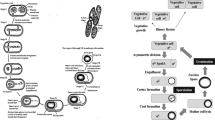Abstract
Porcine pancreatic elastase, a well-characterized serine protease, has been used as a model to assess the effects of excessive humidity on solid-state stability of the lyophilized protein. Elastase lyophilized without excipients retained full activity immediately after freeze-drying but became denatured upon continued storage at 40°C, 75% relative humidity. The extent of inactivation could be monitored through assays of amidolytic activity, as well as through changes in the circular dichroism (CD) and fluorescence spectra. Differential scanning calorimetry (DSC) was employed as a means of screening potential stabilizing additives; based on the results, sucrose and dextran 40 were selected for further evaluation. Both additives were effective in preventing denaturation. Possible mechanisms for the denaturation and stabilization of elastase are discussed.
Similar content being viewed by others
REFERENCES
T. L. Pristoupil, M. Kramlova, H. Fortova, and S. Ulrych. Haemoglobin lyophilized with sucrose: The effect of residual moisture on storage. Haematologia 18:45–52 (1985).
M. J. Hageman. The role of moisture in protein stability. Drug Dev. Ind. Pharm. 14:2047–2070 (1988).
W. R. Liu, R. Langer, and A. M. Klibanov. Moisture-induced aggregation of proteins in the solid-state. Biotechnol. Bioeng. 37:177–184 (1991).
J. G. Bieth. Elastases: Catalytic and biological properties. In R. P. Mecham (ed.), Biology of Extracellular Matrix: Regulation of Matrix Accumulation, Academic Press, New York, 1986, pp. 217–320.
W. Bode, E. Meyer, Jr., and J. C. Powers. Human leukocyte and porcine pancreatic elastase: X-ray crystal structures, mechanism, substrate specificity, and mechanism-based inhibitors. Biochemistry 28:1951–1963 (1989).
L. Greenspan. Humidity-fixed points of binary saturated solutions. J. Res. Natl. Bur. Std. 81A:89–96 (1977).
M. M. Bradford. A rapid and sensitive method for the quantitation of microgram quantities of protein utilizing the principle of protein-dye binding. Anal. Biochem. 72:248–254 (1976).
J. Bieth, B. Spiess, and C. G. Wermuth. The synthesis and analytical use of a highly sensitive and convenient substrate of elastase. Biochem. Med. 11:350–357 (1974).
R. A. Reisfeld, U. J. Lewis, and D. E. Williams. Disk electrophoresis of basic proteins and peptides on polyacrylamide gels. Nature 195:281–283 (1962).
S. Wasi and T. Hofmann. A pH-dependent conformational change in porcine elastase. Biochem. J. 106:926–927 (1968).
G. Jori, G. Galiazzo, and O. Buso. Photosensitized oxidation of elastase: Selective modification of the tryptophyl residues. Arch. Biochem. Biophys. 158:116–125 (1973).
J. M. Imhoff. Selectivity of tryptophyl residues in elastase with 2-hydroxy-5-nitrobenzyl bromide. FEBS Lett. 50:243–244 (1975).
G. Jori and G. Galiazzo. The contribution of the single tryptophyl residues in the fluorescence of elastase. Z. Naturforsch. 296:261–265 (1974).
T. Arakawa and S. N. Timasheff. Stabilization of protein structure by sugars. Biochemistry 21:6536–6544 (1982).
K. Gekko and S. N. Timasheff. Thermodynamic and kinetic examination of protein stabilization by glycerol. Biochemistry 20:4677–4686 (1981).
G. Favre-Bonvin, K. Botancioglu, and J. M. Wallach. Ca2+ and Mg2+ protection against thermal denaturation of pancreatic elastase. Biochem. Int. 13:983–989 (1986).
K. Gekko. Calorimetric study on thermal denaturation of lysozyme in polyol-water mixtures. J. Biochem. 91:1197–1204 (1982).
M. W. Townsend, P. R. Byron, and P. P. DeLuca. The effects of formulation additives on the degradation of freeze-dried ribonuclease A. Pharm. Res. 7:1086–1091 (1990).
M. J. Pikal, K. M. Dellerman, M. L. Roy, and R. R. Riggin. The effects of formulation variables on the stability of freezedried human growth hormone. Pharm. Res. 8:427–435 (1991).
M. Akers. Antioxidants in pharmaceutical products. J. Parent. Sci. Technol. 36:222–232 (1982).
K. Uchida and S. Kawakishi. Selective oxidation of tryptophan and histidine residues in protein through the copper-catalyzed autooxidation of ascorbic acid. Agr. Biol. Chem. 52:1529–1535 (1988).
B. S. Chang and C. S. Randall. Use of subambient thermal analysis to optimize protein lyophilization. Cryobiology 29:632–656 (1992).
C. S. Randall, S. N. Neff, A. J. Perri, and T. D. Sokoloski. Calorimetric studies of elastase: Thermal denaturation and interaction with ligands. Biophys. J. 64:A269 (1993).
Author information
Authors and Affiliations
Rights and permissions
About this article
Cite this article
Chang, B.S., Randall, C.S. & Lee, Y.S. Stabilization of Lyophilized Porcine Pancreatic Elastase. Pharm Res 10, 1478–1483 (1993). https://doi.org/10.1023/A:1018979410338
Issue Date:
DOI: https://doi.org/10.1023/A:1018979410338




